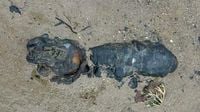On the windswept shores of Drigg beach in West Cumbria, a quiet Thursday evening on October 16, 2025, took a dramatic turn when a member of the public stumbled upon a cache of dangerous military relics. The discovery—seven artillery shells and a mortar—set in motion a rapid and coordinated response that would see the beach transformed into a carefully managed hazard zone, culminating in a series of controlled explosions that echoed across the coastline the following day.
According to Cumbria Crack, the initial alert came when Whitehaven Coastguard Rescue Team received a call from a concerned beachgoer who had spotted what appeared to be old ordnance partially buried in the sand. The team wasted no time, arriving on the scene that night to investigate. Their job was both urgent and delicate: any misstep could have dire consequences, not only for themselves but for anyone in the vicinity.
Upon arrival, the Coastguard officers methodically searched the area, ultimately locating, identifying, and marking each suspicious item. The count was sobering: seven artillery shells and a single mortar, all potentially volatile. The team immediately relayed their findings to their control room and to Explosive Ordnance Disposal (EOD) experts, setting the stage for a larger operation.
As Whitehaven Coastguard Rescue Team explained in a statement cited by Cumbria Crack, "Arriving on scene, we located, identified and marked all items, passing back the relevant information to our control room and EOD Bomb Disposal." The coordination didn’t end there. "Between our officer in charge, bomb disposal commander and control rooms, a plan was made for operations this afternoon."
By the morning of Friday, October 17, the operation had grown in scope and urgency. Whitehaven Coastguard Rescue Team was joined by their counterparts from Millom Coastguard Rescue Team and a specialized bomb disposal unit from the Royal Navy, dispatched all the way from Faslane in Scotland. This collaboration underscored the seriousness of the situation; dealing with unexploded ordnance is never routine, and the risks are all too real.
Safety was paramount. Before any action could be taken, the teams worked to secure a large safety cordon around the affected stretch of beach, keeping the public and any curious onlookers well away from potential harm. The operation required precision, patience, and nerves of steel. The presence of so many shells and a mortar hinted at the long and sometimes hazardous legacy of military activity along Britain’s coasts—remnants that occasionally resurface decades after being discarded or forgotten.
With the area secured, the Royal Navy’s bomb disposal experts took the lead. Working in close concert with the Coastguard teams, they devised and executed a plan to neutralize the threat. The solution: three controlled explosions, each carefully calculated to destroy the ordnance without causing unintended damage to the surrounding environment. As reported by BBC Cumbria, all seven artillery shells and the mortar were safely detonated, ending the immediate danger.
The operation was a textbook example of inter-agency cooperation, with each group playing a vital role. The Coastguard teams provided local knowledge, initial identification, and crowd control, while the bomb disposal unit brought the technical expertise required to handle and dispose of such hazardous materials. Their combined efforts ensured that the incident ended not with tragedy, but with a series of muffled blasts and a collective sigh of relief.
Still, the incident raises important questions about the hidden dangers that can lurk on Britain’s beaches. Drigg, like many coastal areas, has a history intertwined with military training and wartime activity. Over the years, tides and storms can unearth ordnance that was once thought safely buried or lost to the sea. For local residents and visitors alike, the discovery serves as a stark reminder: what looks like a harmless piece of metal in the sand could, in fact, be a deadly relic from the past.
Authorities were quick to praise the vigilance of the member of the public who made the initial discovery, emphasizing that such finds should always be reported immediately and never handled. The Coastguard’s swift response and the professionalism of the bomb disposal team were also lauded. Their actions not only neutralized a real threat but prevented the possibility of a tragic accident.
As Cumbria Crack and BBC Cumbria both noted, this was not the first time that unexploded ordnance has been found along the Cumbrian coast, nor is it likely to be the last. The region’s beaches have, on occasion, yielded similar finds—sometimes harmless, sometimes not. Each discovery is treated with the utmost seriousness, and the protocols followed this week are the result of years of experience and hard-earned lessons.
For the local community, the incident was both unsettling and reassuring. On one hand, the idea that such dangerous items could be lying just beneath the surface is enough to give anyone pause. On the other, the rapid and effective response by emergency services demonstrates a high level of preparedness and commitment to public safety. As one Coastguard officer remarked, "We train for incidents like this, but every situation is unique. It’s always a relief when we can resolve things safely."
The controlled explosions themselves were carried out with minimal disruption to the area. Residents reported hearing the distant booms but expressed gratitude that the matter had been handled so efficiently. The beach was reopened to the public after the all-clear was given, with authorities reminding everyone to remain vigilant and to report any suspicious objects to the proper authorities.
In the aftermath, there’s a sense of gratitude mingled with caution. The events at Drigg beach serve as a timely reminder of the hidden history beneath our feet and the importance of community awareness. It’s a story that could have ended very differently if not for the quick thinking of a passerby and the coordinated efforts of multiple emergency services.
As the waves once again lap quietly against the sands of Drigg, the echoes of those three explosions linger as a testament to the dangers of forgotten ordnance—and the ongoing vigilance required to keep coastal communities safe.
